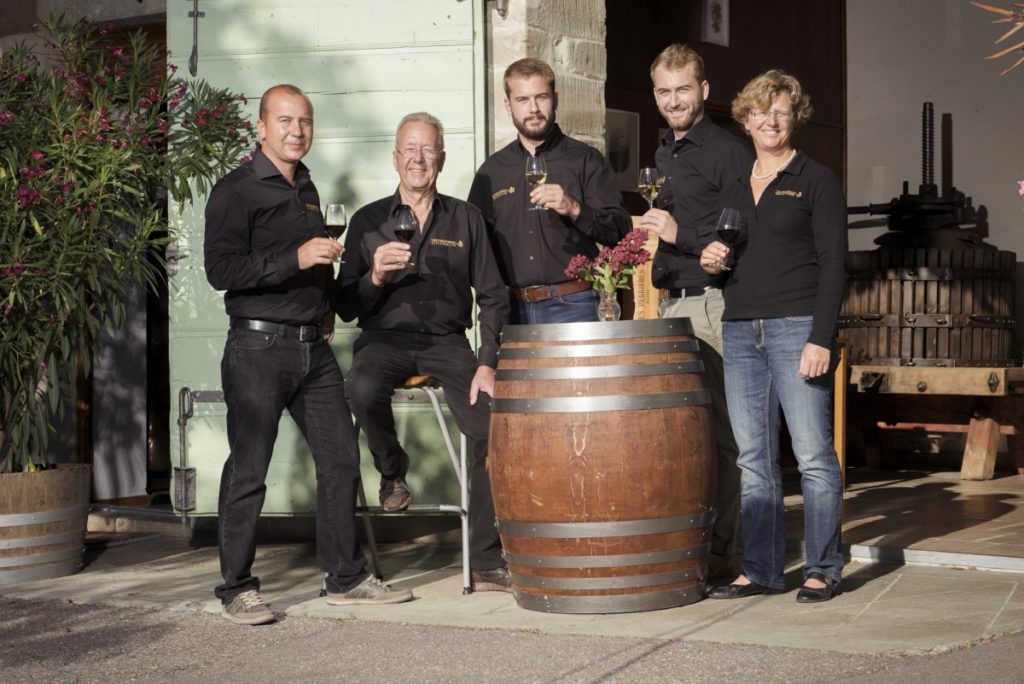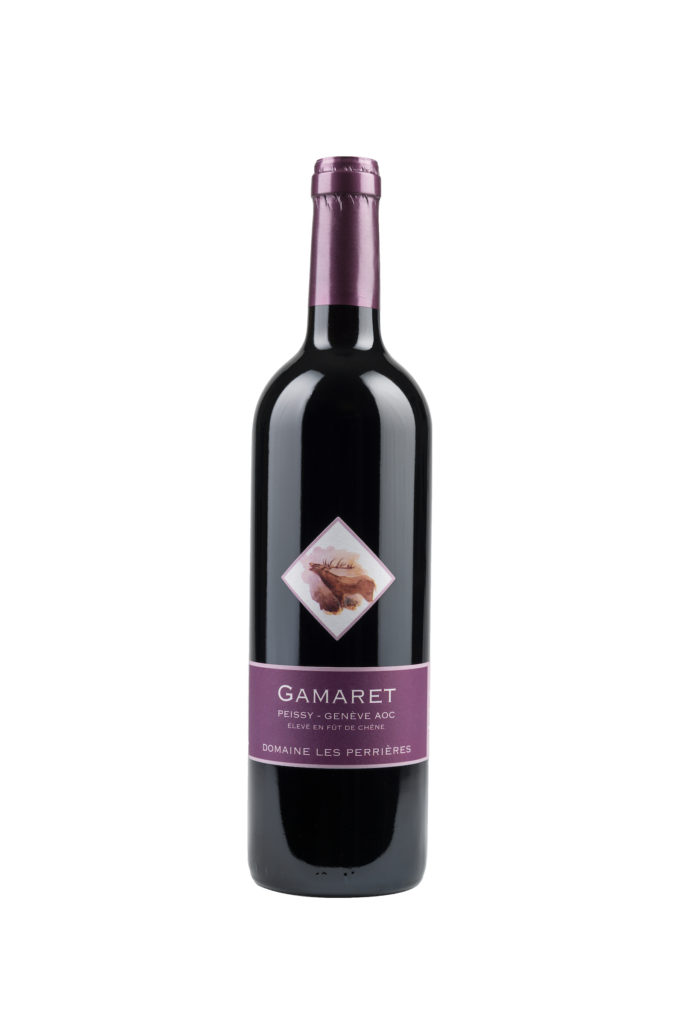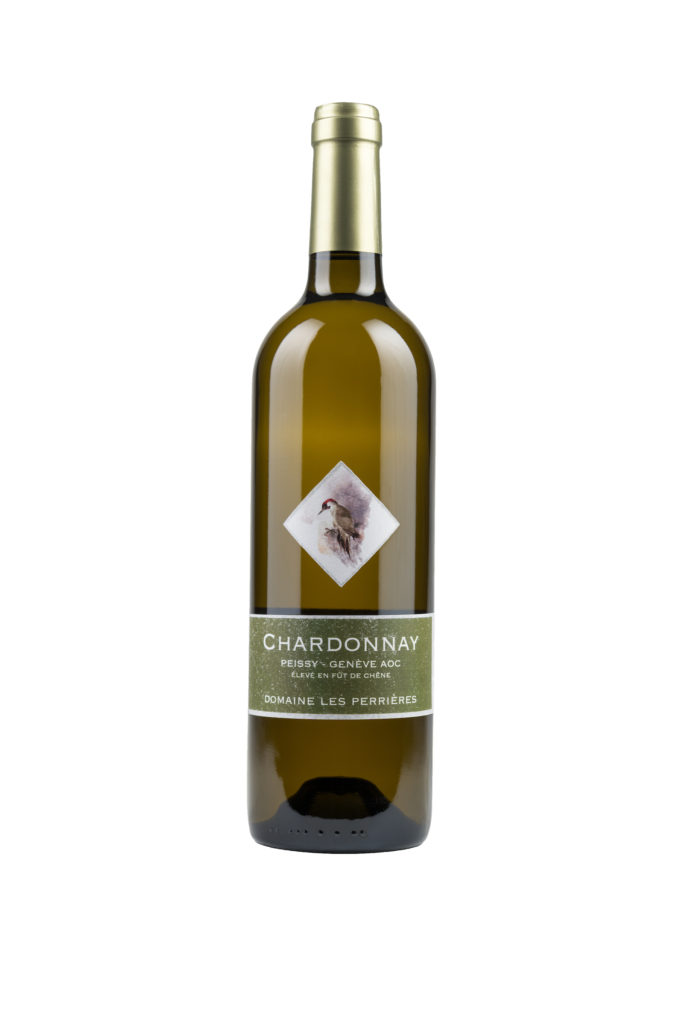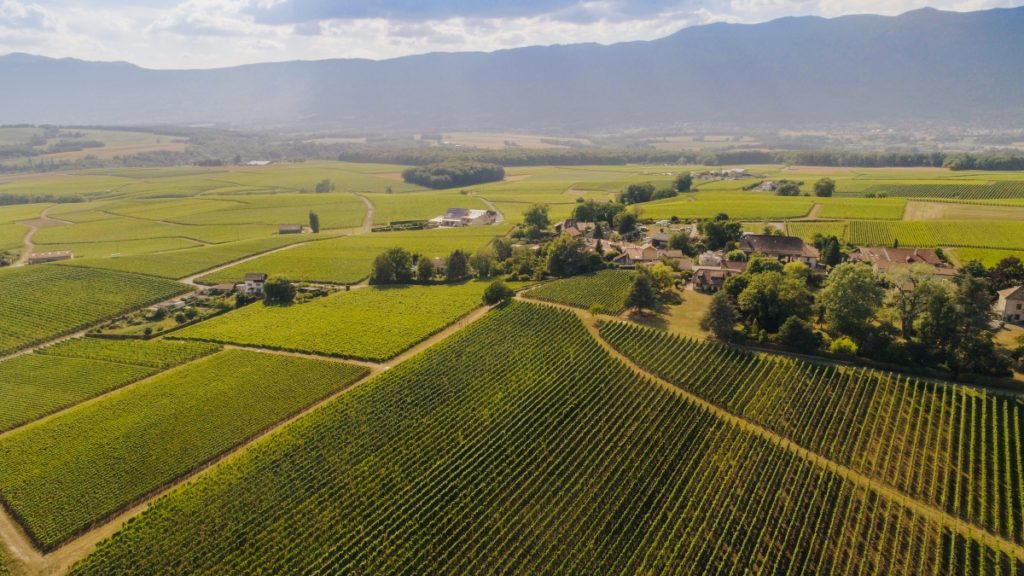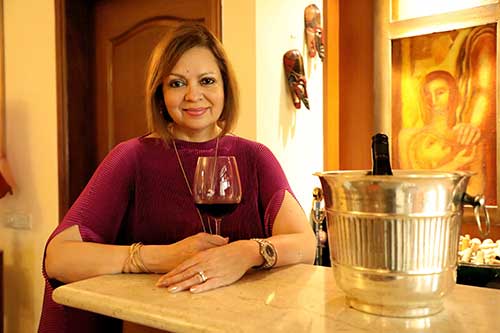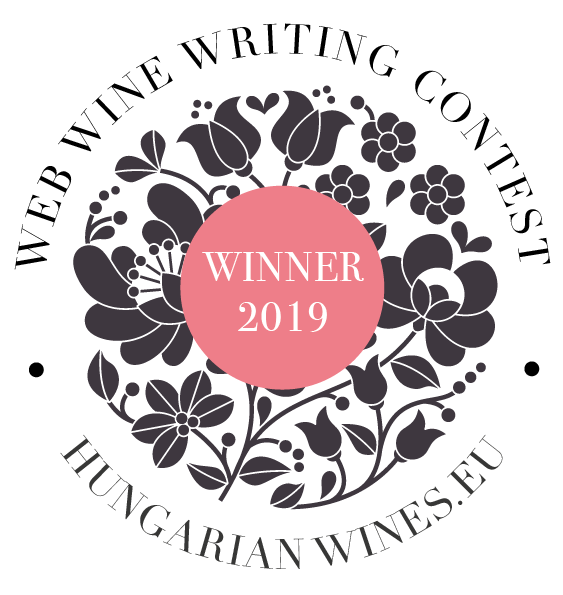You are so wrong, Orson Welles. There is more to Switzerland than brotherly love, peace, and the cuckoo clock. There is wine. But to know Swiss wine, you need to visit the country. Here is why…
There is something about exploring a country through its wine for the first time. As a seeker, there is that mint-new thrill of tasting new wines, understanding the complexities of its terroir and market.
Switzerland is no different. In fact, the thrill of discovery is greater given that so little is known about it worldwide. To quote one of the winemakers I met: “We are the wine world’s best-kept secret.” Big words, but quite true. Most people have heard of Swiss timepieces, chocolate, and cheese. Far fewer have been known to drink Swiss wine… it is not easy to find on international shelves.

The Rochaix family of Les Perrières
Before you flip the page, here are a few facts to mull over first. This tiny country of 8 million inhabitants has a yen for more than their own excellent cheese and chocolate. In fact, they love their wine. So much so that only 1% of their production is exported, which is why you haven’t seen many Swiss wines on the shelves. Switzerland is in fact in the top 10 countries of the world in terms of wine consumption per capita. And they grow a very large number of grapes across their wines regions… which includes Geneva. In fact the vineyards around Geneva house some major producers and grow a large number of grapes, of which Gamay (red) and Chasselas (white) are the most popular.
On the sidelines of the International wine comptition Concours Mondiale de Bruxelles held in Aigle, the jury members were taken around to visit several of the wine regions, taste the wines and meet the producers. One such visit was to Les Perrières, a family-run winery on the outskirts of Geneva. the Rochaix family has been in charge since 1794.
Currently, the 8th generation (three siblings, Frederic, Fabian and Sandrine) is running the business, where they produce approximately one million litres of wine a year.
An appetite for fine wine
Commercial director of Les Perrières and older son of current owner Bernard Rochaix, Frederic Rochaix, proceeded to give me a very succinct and informative introduction to the wines of Switzerland.
“Wine consumption is certainly part of our culture,” he said. “The Swiss consume three times the national production and thus we import a lot from our neighbouring countries, mainly Italy and France, followed by Spain. Efforts are made to export our wines abroad but this is a difficult task as we lack reputation internationally and distributors often fear to reference wines where little demand has manifested itself. Nonetheless, some of the larger Swiss wineries do distribute in Asia and North America with a high end, niche positioning due to their rarity.”
Crossbred, disease-resistant grapes
I was curious about the very large numbers of grapes grown. Switzerland doesn’t have a single native variety save Chasselas, the ubiquitous local white grape. The main regions of Vaud, Valais, Geneva, and Ticino (nearer Italy), a range of grapes are grown, from international favourites like Pinot Noir, Gamay, Chardonnay, Pinot Gris to some rarer ones, the disease-resistant, blood-red Divico, Petite Arvine, Gamaret, etc. “You have a considerably large portfolio yourself,” I asked Rochaix (they produce 29 labels from 17 grape varieties) as we moved from room to room, sipping and spitting a range of white, red sparkling wines, ending up with a rather delicious dessert Muscat matured in oak casks.
That’s right,” he agreed. “Switzerland has a very diverse terroir as well as climate across the country. This has led to significant grape variety diversity with a number of indigenous, international and more modern crossbreeds establishing themselves with success. The canton of Geneva is recognised as being the most diverse canton with many French varieties, such as Chardonnay or Sauvignon Blanc, thriving here and the Swiss crossbreed, Gamaret, also being widely adopted. The canton of Vaud is widely recognized for its wonderful Chasselas which grows on the lakeside and hillsides of the breathtaking UNESCO World Heritage site of Lavaux. The largest Swiss wine producing canton, Valais, has a number of fantastic indigenous varieties as well as international staples, such as Syrah and Cabernet Sauvignon, which thrive in this terroir. The warm and sunny, Italian-speaking canton of Tessin is well known for its Merlot. The cooler and dryer canton of Graubünden for its Pinot Noir….”

Gamaret…. 
and Chardonnay: Hand etched pictures of wildlife on every label
Even within Swiss wine regions, there is depth and difference. What would you say are the pros and cons of such diversity, and what does each bring to the table? I asked.“Diversity is certainly a plus for visiting wine amateurs who can enjoy shifting vineyard landscapes and grape varieties from one canton to the next, agreed Rochaix. “It does, however, pose some difficulty in establishing a reputation at the national level. Each canton has its specialties, terroir and, in some cases, adapted methodologies. Given the size of the already small Swiss national terroir, it becomes very difficult for each canton to market itself individually, internationally. Other small European wine producing countries have managed to position themselves and create a name around one variety, this is challenging for Switzerland, although attempts are now being made to push the Chasselas forward as this identifying product. I remain convinced that each region brings something unique to the table, each holding its own merit,” he said.
Swiss baby: Chasselas
So tell me more about Chasselas, I asked him. “What qualities according to you, make it so special? How do you explain its dominance in Switzerland over other cool-weather grapes, for instance, the Pinots and Riesling?
Recent genetic studies have led experts to believe that Chasselas originated in the Lemanic Region (Lake Geneva region) with documented references dating back to the 17th century, Rochaix tells me. “Chasselas is the most represented white in Switzerland accounting for approximately 26% of the national surface area (of vineyards). The indigenous nature of this variety and its wonderful characteristics – floral bouquet, apple & pear aromatic profile, varying minerality by terroir, a tendency for the berries to turn golden under the sun, and an abundant growth profile – make it an all-round favourite among winemakers and subsequently consumers.” Chasselas can be drunk as an aperitif and marries itself with the national cheese dishes: Raclette and fondue (the recipe for a traditional Swiss fondue includes the addition of Chasselas in the cheese mix). “It is crisp and fresh and to many people’s surprise, ages wonderfully both under cork and capsule. Further to this, Chasselas appears to adapt well to the warming summers of recent years,” he adds. With the looming threat of climate change, the last bit is very important, I’d say.

The vineyards of Les Perrières
Wine tourism & coping with climate change
For wine drinkers interested in tasting Switzerland’s wines, what advice would you give, given the number of wine regions to explore, I asked?
“As I mentioned, Switzerland has a lot to offer from its natural beauty to its world renowned industries with touristic attractions located all around the country. As a result, it doesn’t make sense to travel to Switzerland exclusively for wine, but it certainly makes sense to include some oenotourism (wine tourism) within your planned voyage,” he replies, “Information is abundant online and with some careful planning you can be sure to see and taste some pretty unique stuff during your trip. For example, our estate is a 7-minute drive from Geneva’s international airport and about 20 minutes from the city centre. Further to this, be sure to insist to drink local wherever you go in Switzerland (and by local I don’t mean Swiss but the specific canton you are located in). Most cantons produce wine and if you insist on this point your sommelier will be able to recommend something from the area which is worth a taste.”
Looking ahead to the climate change issue looming large in the wine world as well, how are the Swiss as an industry coping, I wondered. “What changes do you predict you will see in Switzerland?”
“Given the diversity, we already have some well adapted varieties planted and producing. We’ve had some hot years of late like 2015 and 2017, which have yielded fantastic wines, some of which were recently prized at the Concours Mondial de Bruxelles 2019 in Aigle. 2018 was completely off the charts in terms of temperatures with very little rain. Everything I’ve tasted from the 2018 vintage has been very rich and for the most part, encouraging. In my eyes, Switzerland is well prepared for the increase in temperatures as we have quite some way to go until our climate is the likes of southern Italy or Spain. On the other hand, hail and frost remain a constant threat as the increased weather extremes do swing both ways,” he said.
Secret no more?
I wondered aloud if we would ever see Switzerland stepping out of its ‘best kept secret’ shadow and on to the world stage? Or would the high local consumption going to deny this? “There were a very large number of Swiss entries in the Concours this year… does this indicate that things are changing in terms of a higher profile?”
“Despite the large local consumption we certainly have capacity and appetite for increased exports,” admits Rochaix, “The local market is fierce and in high-yielding vintages such as 2018, large market players drive prices down aggressively. Furthermore, local viticulture receives very little protection from the importat market with import quotas not having been revised in decades. This is a shame as production costs (primarily labour) from competing countries are most often significantly lower than those we face within our borders.” The increase of Swiss entries in the CMB 2019 was likely due to it taking place in Switzerland, nonetheless, a fifth place overall showing (for number of medals) is encouraging and will draw some attention, he added.
What about Les Perrières own portfolio? Are they planning on adding more labels to their already considerable range? They certainly seem to be able to.
Rochaix laughed. “Given our already significant portfolio of 29 products we are reticent to make any abrupt additions especially given the climate considerations we just talked about. We are, however, monitoring the progression of certain varieties which are naturally resistant to diseases. Switzerland, true to its broader reputation, has fantastic research facilities and teams which create naturally resistant crossbreeds, such as the Gamaret (Gamay X Reichensteiner) in 1970, which are already thriving in the Lemanic Region and across the country.
“Their quest is ongoing and so is ours as these may represent the future of viticulture.”
Bold words. But if anyone can do this, with their legendary cuckoo-clock precision and efficiency, the Swiss surely can…
Listen to Frederic Rochaix talk about Gamaret, the unique Swiss disease-resistant grape in my YouTube video.
Contact: Cave & Domaine Les Perrières S.A., Road to Peissy 54CH-1242 Peissy / Satigny, Geneva, Switzerland. Winery visits by appointment. Email: info@lesperrieres.ch


